Retrofitting report







Barry Quinlan, Assistant Secretary at the Department of the Environment, Climate and Communications (DECC) with responsibility for built environment, retrofit, and heat policy, tells eolas Magazine about the steps ahead in Ireland’s retrofitting journey.
Retrofitting in Ireland has gone from being a niche preoccupation to priority national policy. Quinlan began his role in late 2021, a period marked by the onset of the war in Ukraine, which underscored the urgent need to reduce dependence on the importation of fossil fuels and transition to a net zero economy.
While admitting that the scale of the challenge – retrofitting hundreds of thousands of homes while simultaneously building new ones – seemed “daunting”, he says that he has been “consistently impressed” by the sector’s growth and adaptability.
“The numbers speak for themselves. Between 2021 and 2023, spending on retrofitting increased by a staggering 220 per cent, rising from €99 million to €325 million. The number of upgrades more than doubled, with 48,000 homes retrofitted in 2023 compared to just 15,220 in 2021.
“The success of the free upgrade Warmer Homes Scheme, which has seen a 160 per cent increase in activity, highlights the programme’s impact on lower-income households.”

These achievements, he states, have placed Ireland “at the forefront of retrofit innovation globally”, with other EU countries and the UK looking to Ireland as a model of best practice.
According to Quinlan, success on Ireland’s retrofitting journey stems from two critical factors: a credible, wellfunded plan and a strong delivery team.
He says that that the National Retrofit Plan benefits from long-term financial certainty. “The allocation of a total of €8 billion to the National Development Plan ensures predictable annual increases, enabling DECC and the Sustainable Energy Authority of Ireland (SEAI) to plan effectively,” he says.
Quinlan also says that partnership between the State and industry has been “instrumental”, adding: “The attitude of DECC and SEAI to driving delivery with the industry is really important. We have faced challenges together and dealt with them swiftly to keep the programme moving forward.”
Despite the progress, significant hurdles remain. Quinlan outlines several key challenges and the solutions being implemented:
1. Demand generation: Many homeowners perceive retrofitting as costly or overly complex. To combat this, the Government offers grants covering up to 30 per cent of the cost – a level of state support significantly higher than exists in other countries. Awareness campaigns and efforts to reduce the “hassle factor” are also helping to drive demand.
2. Financing: For those ineligible for free upgrades, financing remains a barrier. To address this, DECC introduced a €500 million low-cost loan scheme in collaboration with the Strategic Banking Corporation of Ireland (SBCI), the European Investment Bank (EIB), and commercial banks. With rates as low as 3 per cent, this scheme aims to make retrofitting more accessible to middle-income households.
“The allocation of a total of €8 billion to the National Development Plan ensures predictable annual increases, enabling DECC and the Sustainable Energy Authority of Ireland (SEAI) to plan effectively.”
3. Supply chain and skills: The rapid pace of retrofit activity has strained the supply chain and workforce. In response, DECC has partnered with the Department of Further and Higher Education, Research, Innovation and Science to develop training programmes and financial incentives for upskilling. This ensures that workers can retrain without losing income.
4. Governance and oversight: As the programme scales, robust governance is critical. DECC’s quarterly reports provide transparency, dispelling myths and allowing stakeholders to monitor progress.
While Quinlan commends the sector for its achievements, he emphasises that Ireland is still “in the foothills” of its retrofit journey. The goal of retrofitting 500,000 homes by 2030, with 400,000 adopting heat pumps, will require “another leap in ambition and innovation”.
The next phase will involve addressing more complex retrofits and deeper energy upgrades. Quinlan points out that some of the “low-hanging fruit" has already been picked, meaning future projects will require greater coordination and investment.
However, he expresses confidence in the sector’s ability to rise to the challenge, particularly given the political support retrofitting has garnered.

Quinlan calls on industry leaders to be “ready and be ambitious”. “With funding secured and demand continuing to grow, the onus is now on the sector to deliver at scale,” he says, asserting that businesses must be prepared to invest in skills, expand capacity, and prepare for “the next wave of activity”.
One of the programme’s greatest strengths, Quinlan asserts, is its crossparty political support, pointing to the fact that there were significant retrofit policy proposals in all the major parties’ general election manifestos.
Quinlan says that this political consensus, combined with Ireland’s strong economic performance, provides “a stable foundation for the sector’s growth”.
Concluding, Quinlan says that Ireland’s retrofit programme is “not just a climate initiative”, adding: “It is a transformative economic opportunity. By reducing emissions, improving energy efficiency, and creating jobs, it delivers benefits across society. While challenges remain, the sector has proven its resilience and adaptability.”
He summarises: “With strong foundations in place, Ireland is well positioned to achieve its retrofit targets and set a global standard for sustainable building practices.”
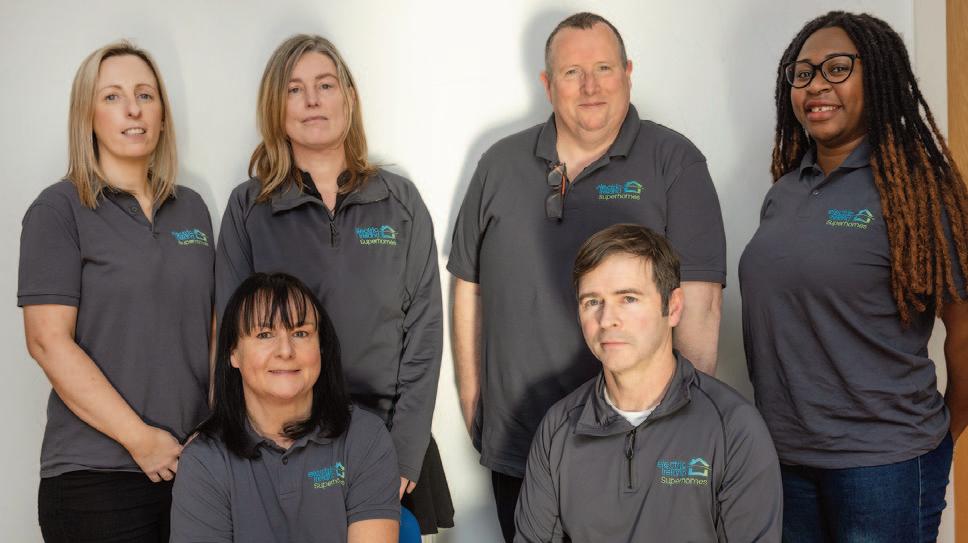
Electric Ireland Superhomes is a joint venture between Tipperary Energy Agency and ESB (Electric Ireland) established in 2021.
We are an SEAI registered one-stop shop looking after all the key stages of a home energy retrofit, from design, contractor selection, project completion, and management of SEAI grant funding to bring houses and apartments to a minimum of a B2 BER standard. Electric Ireland Superhomes’ vision is to empower our customers to achieve warmer, healthier, low-carbon homes with a renewable energy focused approach. We are currently on track to achieve our target of retrofitting over 30,000 homes by 2030.
Electric Ireland Superhomes delivers

retrofit solutions with the support of a multi-disciplined staff of over 50 people comprising of retrofit advisors, energy engineers, surveyors and BER assessors. We now have a dedicated team that specifically focuses on larger projects with special focus on housing owned and managed by local authorities, approved housing bodies and non-corporate landlords. This team is led by Mike O’Rourke who has over 28 years’ experience in building services engineering, with the last 7 years in the housing retrofit sector and supported by David Ahearne with over 25 years in project and account management roles
and experience within the retrofit sector.
The dedicated ‘large projects’ team bring a wealth of expertise in planning, execution, and oversight, ensuring that projects are delivered on time and within budget. With a keen understanding of the intricacies of project management, they can effectively navigate potential challenges, mitigate risks, and optimise available resources. Their ability to anticipate potential roadblocks and implement strategic solutions contributes to the overall success of the project.
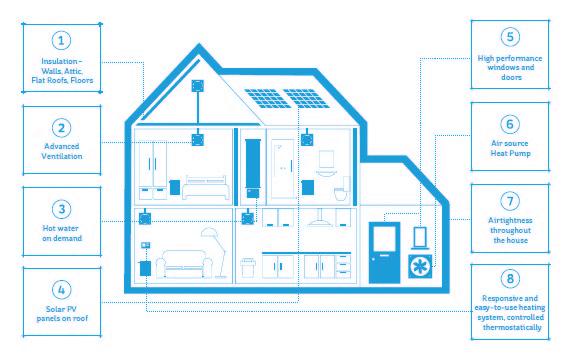
Ultimately, by entrusting Electric Ireland Superhomes with the oversight of their energy efficiency retrofit programme, a local authority or approved housing body stands to benefit from enhanced efficiency, cost-effectiveness, and successful project outcomes.
For local authorities, Electric Ireland Superhomes can provide a range of services to meet their needs from a full energy retrofit consultancy service to the provision of services expected under the Energy Efficiency Obligation Scheme.
From 2022 to date, our large projects team have been engaged by several local authorities, for the delivery of energy retrofit works of over 1000+ units.
Our minimum objective is to deliver a B2 post BER rating on all homes and in 2023 44 per cent of all our local authority houses achieved an A post BER rating.
This year we have been contracted by additional local authorities for their energy efficiency retrofit programme and are forecasting significant growth in this sector.
For approved housing bodies and noncorporate landlords, Electric Ireland

“Ultimately, by entrusting Electric Ireland Superhomes with the oversight of their energy efficiency retrofit programme, a local authority or approved housing body stands to benefit from enhanced efficiency, costeffectiveness, and successful project outcomes.”
Superhomes can provide a full one-stop shop service that can avail of the SEAI grants for houses that were built and occupied before 2011 and have an existing BER of B3 or lower. SEAI grants supported retrofit measures include insulation upgrades (including roofs, walls, and floors), replacement doors and windows, mechanical ventilation, airtightness, solar PV, and heat pumps.
The process for an energy retrofit starts with an initial consultation to establish your requirements followed by a detailed house survey that includes the building fabric and heating systems. An energy report is then prepared that recommends a package of measures. Once satisfied with the recommendations in the report, we can finalise the design of the works, prepare documents for tender or pricing, and manage the grant process. We carry out
interim checks on the retrofit works in progress and a detailed final inspection once the project is completed. A health and safety file and post works BER Certificate are provided on completion of the project.
Grants offered are provided by the Government of Ireland through the Sustainable Energy Authority of Ireland (SEAI).
For more information contact: Mike O’Rourke +353 86 440 2565 Head of Contracting and Safety
E: mike.orourke@electricirelandsuperhomes.ie David Ahearne +353 87 489 6572 Corporate Account Manager
E: david.ahearne@electricirelandsuperhomes.ie Or email multiples@electricirelandsuperhomes.ie


Paul Kenny, Director General of the European Heat Pump Association, talks to eolas Magazine about the role of heat pumps in Europe’s energy future, emphasising Ireland’s progress and the broader European landscape.
Europe remains heavily dependent on fossil fuel imports, which are costly, insecure, and undermine economic competitiveness. “Energy is the area where Europe struggles in terms of competitiveness,” Kenny states, highlighting the urgent need for decarbonisation and the central role of heat pumps in this transition.
Stressing that through the Fit for 55 package, Europe’s heat decarbonisation ambitions are steadfast, Kenny draws attention to the geopolitical dimension of energy, particularly the influence of misinformation campaigns targeting climate policies and heat pumps. “There is a concerted disinformation effort, particularly in Poland, aimed at undermining the deployment of heat pumps,” he notes.
Europe’s strategic heat pump advantage
Unlike solar photovoltaics (PV) and electric vehicles, where Europe has lost its competitive edge to China, Kenny asserts that Europe remains a leader in heat pump technology.
“We maintain a stronghold in industrial, domestic, and commercial applications. Even Asian manufacturers produce for the European market within Europe,” he explains, further claiming: “This presents a strategic opportunity that must be safeguarded.”
“Smart integration of heat pumps with dynamic electricity pricing could reduce energy costs by between 30 per cent and 40 per cent, mirroring successful models in Sweden.”
Paul Kenny, Director General, European Heat Pump Association
The Renewable Energy Directive sets a 42 per cent target for renewable energy, up from the current rate of between 14 per cent and 15 per cent. Kenny says that “the only viable pathway to achieving this is through the widespread deployment of heat pumps and renewable electricity”.
Observing that “several regulatory barriers hinder the rapid expansion of heat pumps across Europe,” Kenny says that “in some countries, planning permissions, noise assessments, and heat loss assessments create unnecessary delays”. “Harmonising and streamlining these processes”, he says, will be “critical to accelerating adoption”.
Kenny also emphasises the impending shift in refrigerants from synthetic gases to propanebased alternatives, a transition mandated by EU law by 2027. “This will increase material costs by approximately 30 per cent, which will inevitably impact pricing,” he says, further noting that policymakers “must account for these economic shifts to ensure sustained market growth”.
Kenny highlights Ireland’s progress in renewable energy, citing significant advancements in grid infrastructure, battery storage, and interconnection. “The commissioning of new interconnectors in the coming years will reduce reliance on gas for electricity generation and lower electricity prices,” he says.
The State’s commitment to flexibility in its climate plan is also noted by Kenny as a “competitive advantage”. “Smart integration of heat pumps with dynamic electricity pricing could reduce energy costs by between 30 per cent and 40 per cent, mirroring successful models in Sweden,” Kenny states.
Another critical factor for success cited by Kenny is installer capacity. “In markets with high heat pump adoption, installation margins are lower, making the technology more accessible,” he explains. “In contrast, in Germany, profit margins on installations remain excessively high, limiting widespread uptake despite generous subsidies.”
Public awareness and regulatory stability also play “crucial roles”. “In Sweden, younger generations have no concept of gas boilers; they only know heat pumps,” Kenny says, further asserting that replicating this societal shift across Europe requires “consistent policies and investment in consumer education”.
Kenny calls for decisive policy interventions to sustain the momentum in heat pump deployment:
• Lowering VAT on heat pumps: “Ireland was restricted from reducing VAT below 9 per cent due to EU law, but forthcoming directives will enable reductions to 0 per cent.”
• Expanding installer training programs: “Every installer must be equipped to recommend and install heat pumps as a default solution.”
• Enhancing grid integration: “Ensuring that heat pumps can dynamically respond to electricity pricing will maximise cost efficiency.”
Kenny reaffirms that the State is on the right trajectory but, cautions that government “must remain committed to investment and strategic policymaking”.
“Ireland’s energy policies are widely regarded as a model within Europe,” he asserts.
“While ambitious targets may not be fully met, structured implementation will ensure continued progress toward a sustainable and secure energy future,” Kenny concludes.



As housing providers seek to upgrade older homes to modern standards and embed sustainability into their practices, Tuath Housing Association and KORE Retrofit are breaking new ground with an innovative retrofitting initiative.
Tuath Housing Association is a not-forprofit approved housing body, providing long-term, safe, and quality housing. The organisation currently manages over 15,000 homes, catering to the needs of over 38,000 people. Tuath endeavours to prioritise environmental stewardship and sustainable practices in all aspects of its work.
KORE Retrofit is a County Cavan-based business that is committed to delivering eco-friendly retrofits and energy
upgrades to create energy-efficient, sustainable homes across Ireland.
Together, Tuath and KORE are the driving forces behind Circular Reno in Ireland.
Circular Reno is an EU-funded project aiming to implement biobased materials in home retrofits and create an action
plan to address housing and energy challenges. The project brings together four EU social housing providers; Tuath Housing Association (Ireland), Vilogia (France), Wonion (Netherlands) and LEG (Germany), alongside construction and retrofit companies and facilitators, to exchange knowledge and ideas. It also aims to develop the biobased building material sector and to support the transition to biobased materials.
The need for sustainable solutions in construction and retrofit materials has never been more important as the drive to reduce the sector’s impact on the planet gains momentum. Increasing regulation means the sector will be required to account for embodied carbon emissions and address circularity concerns.
Locally sourced biobased building materials can offer a solution; eliminating emissions associated with the extraction, production and transportation of traditional materials. Biobased materials such as hemp and straw even absorb and store carbon dioxide during their growth, effectively acting as carbon sinks meaning we can literally ‘build with carbon’. In addition, biobased materials often emit fewer volatile organic compounds, promoting better indoor air quality. Finally, at the end of their lifecycle, biobased materials decompose naturally, reducing landfill waste and environmental impact of demolition.
However, the availability of affordable, eco-friendly construction materials is limited in Ireland and policy and regulation in this space is in its infancy. Meanwhile, farmers are seeking new opportunities to diversify their activities, especially in the context of the climate crisis. Circular Reno connects the construction and agriculture sectors by establishing a value chain working group for biobased materials.
Tuath and KORE have completed two pilot homes under this initiative to date, the first in Clonygowan, County Offaly and the second in Ballycumber, County Offaly.
Both homes were fitted with off-site manufactured wall panels with a biobased EPS glue. These panels were installed using a bracket on the exterior walls, significantly reducing installation time compared to traditional external wall insulation systems.
Additional upgrades to these two homes included:
• full demand control ventilation;
• air-to-water heat pumps;
• solar panel systems;
• new triple-glazed windows and doors;
• pumped cavity wall insulation; and
• 300mm hemp insulation installed in the attic/roof space.
The works to the second home also included the removal of a solid fuel cooker and the addition of a stove.
The homes were transformed by the retrofits. The first house went from a D2 BER rating to an A1 rating while the second house went from C3 to A1.
The first home achieved an air tightness rating of 2.363, while the second home achieved a rating of 2.625; reducing uncontrolled air leakage and improving comfort and cost efficiency.
While still in its infancy in Ireland, Circular Reno is already making an impact.
By testing and developing solutions now, ‘Reno’ properties take steps to align with the EU’s commitment to carbon neutrality and requirements for all residential buildings to be ‘climate neutral’ by 2050.
For those in construction, Circular Reno provides a model for integrating biobased materials into retrofitting practices. The project shows how using materials like biobased foam insulation and modular construction panels can help Ireland achieve its energy efficiency targets while reducing reliance on fossil-based materials.
In the farming sector, promoting agricrops for biobased construction materials provides new income streams

“We look forward to building on our success with retrofits to more of our
while offering opportunities for agricultural diversification.
Importantly, participating tenants are benefitting from lower energy bills, increased thermal comfort and improved indoor air quality, contributing to their overall health and wellbeing.
As each home is retrofitted under Circular Reno, the project partners continue to increase process efficiency and efficacy. By strategically planning the retrofitting of each home and completing as much work off-site as possible, there is less disruption to residents while time spent onsite is streamlined.
In the first home of this project, the EPS arrived onsite in panels but had to be rendered while the windows needed to be installed. In the second home, the base coat for the render was completed at a factory offsite while the windows were installed within the panel itself. As a result, the second home’s occupants left for work in the morning and upon their return in the evening, the wall
panels, windows and doors were installed and the house had returned to being airtight.
Brian Flax, Marketing Manager, KORE Retrofit says: “Throughout these two retrofits, we have made significant progress in how we carry out the work; continuously improving processes to deliver excellent results for all stakeholders.
“The achievements here will stand to us as we continue with the Circular Reno initiative.”
Nick Sheward, Director of Property Services, Tuath Housing, says: “We are very proud to be partnering with KORE to ensure that our residents’ homes are comfortable, sustainable and energyefficient. We look forward to building on our success with retrofits to more of our homes.”
W: www.tuathhousing.ie
W: www.koreretrofit.com




While significant progress has been made towards the State’s residential retrofit targets, these are challenged by financial, structural, and policy-related obstacles. Accelerating delivery will depend on a collaborative approach write Ciara Ahern, senior lecturer, and Elihu Essien-Thompson, software engineer and data analyst, with TU Dublin.


In 2019, the European Commission published the European Green Deal, setting an ambitious target for European Union (EU) member states to achieve net zero carbon emissions by 2050. This directive mandates a 55 per cent reduction in net greenhouse gas (GHG) emissions by 2030, relative to 1990 levels.
In Ireland, the residential sector is a significant contributor to GHG emissions, primarily due to the age of its housing stock; approximately 67 per cent of European homes were constructed before 1980, predating modern thermal building regulations. With a replacement rate of less than 0.1 per cent annually, most of these dwellings will still be in use by 2060, underscoring the critical need for energy-efficient refurbishments.
To address this, Ireland's Climate Action Plan (CAP) was introduced in 2021, aiming for 500,000 residential retrofits to achieve a Building Energy Rating (BER) of B2 or higher, and the installation of 400,000 heat pumps by 2030. These initiatives are paramount to reducing the residential sectors carbon footprint. Ireland’s Energy Performance Certificate (EPC) or Building Energy
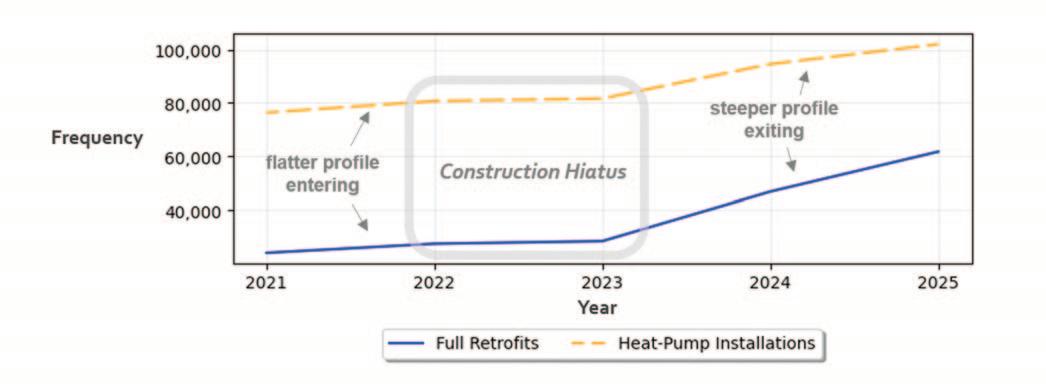

Rating (BER) database plays a central role in this strategy, providing empirical data on a dwelling's retrofit status. As of the third quarter of 2024, over 1.26 million EPCs have been issued in Ireland, covering 66 per cent of the nation's 1.86 million occupied dwellings.
The Irish Building Stock Observatory (IBSO), established in 2022, has been instrumental in processing and validating this data, offering quarterly snapshots that reflect the refurbishment status of Ireland's housing stock, as shown in Figure 1.
Analysis of IBSO data from 2020 to 2024, and as shown in Figure 2, reveals a notable trend: while there was a decline in retrofit activities during the Covid-19 pandemic and the subsequent construction hiatus caused by global events, a significant rebound occurred post-2023. This resurgence indicates a growing momentum towards achieving the CAP's targets.
However, projections based on logistic market modelling suggest Ireland is projected to meet its B2 retrofit target by 2032, slightly exceeding the original 2030 goal by two years. The heat pump installation target, however, presents a more significant challenge, with forecasts estimating that the 400,000-unit goal will not be achieved until 2042 under current trends.
These projections account for market growth phases, including acceleration, saturation, and eventual plateauing. The data suggests that the initial surge in retrofits post-2023 will slow as the easier-to-upgrade dwellings are completed, requiring more aggressive policies and incentives to maintain momentum and address complex retrofit cases.


A deeper dive into retrofit rates by dwelling typology reveals disparities. As shown in Figure 3, detached and semi-detached houses have seen the most significant increases in B2 retrofits, with 295 per cent and 209 per cent growth respectively between 2021 and 2024. In contrast, apartments, particularly mid-floor units, exhibit lower retrofit rates. This discrepancy is partly due to the inherent energy efficiency of
Figure 4: Proportion of EPC ratings across the Irish housing stock in 2024



apartments, which benefit from shared walls and reduced exposure, but also points to potential challenges in mobilising retrofit initiatives within multi-unit dwellings.
Financial considerations play a pivotal role in retrofit decisions. As can be seen from Figure 4, C-rated homes dominate the EPC landscape. Homeowners in C-rated dwellings often face a “comfort barrier”, perceiving their homes as sufficiently comfortable with manageable energy costs, thus diminishing the incentive for extensive retrofits.
Moreover, while achieving a B2 rating can be costly – often requiring significant investments in insulation, window replacements, and heating system upgrades – access to green mortgages and preferential financing is typically available starting at a B3 rating. This financial structure may inadvertently discourage homeowners from pursuing the more ambitious B2 upgrades.
Case studies further illustrate these challenges. For instance, as shown in Figure 4, a 1980s three-bedroom semi-detached house underwent three retrofit scenarios to a B2 energy rating that vary in cost and complexity: one involving the replacement of an open fire with a stove and window upgrades, the second scenario remove the fire entirely without window enhancements, and the third assessed principally using PV panels to achieve the B2 energy rating.
All approaches achieved a B2 rating, but none met the Heat Loss Indicator (HLI) threshold of 2.3 W/k/m2 required for heat pump grants. Notably the homeowner would have been able to achieve the green mortgage threshold at a significantly lower investment cost than that of meeting the B2 policy target.
To bridge the gap between current progress and the 2030 targets, several strategies are recommended:
1. Coherent financial incentives: Aligning grant structures and green financing options to reward deeper retrofits can motivate homeowners to aim for B2 ratings specified in the Climate Action Plan.
2. Targeted outreach: Focusing on dwelling types with lower retrofit rates, such as older apartments, through tailored programs can address specific barriers these units face.
3. Policy adjustments: Aligning the B2 target with the HLI index to create a pathway to heat pump adoption more accessible. This could be supported by a higher level of financial incentives to encourage homeowner adoption.
In conclusion, while Ireland has made commendable strides in its residential retrofit journey, achieving the ambitious 2030 targets necessitates a multifaceted approach. By addressing financial, structural, and policy-related challenges, and fostering collaboration among stakeholders, Ireland can accelerate its progress towards a more energy-efficient and sustainable housing stock.


Catherine Hannon, Head of Public Affairs and Sustainability at Calor Ireland, discusses the opportunity of a mixed technology approach to retrofitting and heat decarbonisation versus a ‘one size fits all’ solution. She emphasises that providing choice and affordability is essential to empower rural homeowners to contribute to Ireland’s energy transition.

“Choice and affordability are crucial for rural energy consumers who are located off the natural gas grid or living in older homes using higher carbon fuels like oil, coal, and peat,” explains Catherine Hannon. “Consumers should be provided with a range of options, including cleaner, lower carbon, and renewable liquid gases, along with improved energy efficiency measures”.
With the increasing spotlight on the evolution of Ireland’s energy needs, there is a growing push to reduce the environmental impact of our energy choices and cut carbon emissions. At
this critical juncture for achieving our climate targets, companies must offer pragmatic solutions to the energy and environmental challenges our society faces.
The success of Ireland’s ambitious retrofitting and decarbonisation targets hinges on our ability to develop policies and solutions that are not only environmentally sound but also socially and economically viable. Data* that was reported in 2024 around the continued increase in oil usage for home heating in Ireland, highlighted the urgent need for a variety of solutions, particularly in the retrofitting sector, a trend that continues to impact the housing market indicating that government and industry must collaborate to deliver innovative and inclusive approaches to retrofitting homes.
For nearly 90 years, Calor has provided clean, reliable, lower carbon energy to homes and businesses across Ireland, especially in rural areas. Calor’s mission is to drive Ireland’s energy transition and create a sustainable future for generations to come. This mission is supported by Calor’s reaccreditation to
the Business Working Responsibly Mark in 2024, Ireland’s third party (NSAI) verified Environmental, Economic, Social, and Governance (EESG) standard.
Calor’s responsible product strategy aims to ensure that the source and supply of its products become increasingly renewable and sustainable to meet future customers’ needs. The launch of a certified renewable liquid gas (BioLPG) in 2018, demonstrated Calor’s commitment to playing an active role in Ireland’s transition to a decarbonised economy. BioLPG, or bio propane, is chemically indistinct from LPG and as a ‘drop-in’ fuel, can be blended with LPG without a change of equipment.
Renewable-ready gas boilers combined with solar PV and moderate retrofitting measures can also result in increased energy efficiency and lower carbon emissions at a significantly lower upfront cost. LPG and BioLPG can also be used seamlessly in cutting-edge heating systems, such as hybrid heat pump installations.
By expanding the choices available to homeowners, Ireland’s retrofitting goals could be greatly accelerated. Currently, the scale of the task risks overwhelming consumers in rural off-grid areas, leading to disengagement and inaction. Recognising the significance of factors influencing adoption is crucial, especially when considering that climate targets require behavioural changes among citizens and urgent, transformative actions in key industries such as housing, transportation, and power generation.
The most recent report* by Liquid Gas Ireland (LGI) which analysed the latest census data, found that 46 per cent of all households still rely on high carbon fuels, including oil, peat, and coal, for heating. There has also been a national increase in the number of homes using oil since 2017. While the overall national proportion of households using these high carbon fuels has slightly decreased since 2017, the total number of housing units using oil has increased by 28,173 to 714,177.
“When examining the data in more detail, it is clear that in some counties, especially those off the natural gas grid, homeowners are highly reliant on oil for heating. The LGI report shows that 66 per cent of homeowners in Donegal rely
“Choice and affordability are crucial for rural energy consumers who are located off the natural gas grid or living in older homes using higher carbon fuels like oil, coal, and peat.”
Catherine Hannon, Head of Public Affairs and Sustainability at Calor Ireland.
on oil, and this trend is replicated in other counties such as Mayo (61 per cent), Monaghan (75 per cent), and Kerry (63 per cent).”
Another consideration is the age of Ireland’s housing stock. According to CSO figures analysed by LGI, 65 per cent of all houses were built before 2002, equating to just over 1.2 million homes. These homes are typically less energyefficient and more costly to heat.
This ageing infrastructure poses a significant challenge and often requires more extensive and costly interventions. It is not just about environmental impact; it is about the economic feasibility for homeowners.
“Many off-gas-grid buildings are older and difficult to electrify. For heat pumps to operate effectively, homes need to be well-insulated, often requiring an expensive, deep retrofit and the inconvenience of vacating the property during construction. This is not a viable option for everyone, so solutions to decarbonise these households should be flexible enough to meet their needs.” states Hannon.
Calor’s traditional LPG product allows rural off-grid consumers to transition from higher carbon and more polluting fuels such as heating oil, coal, and peat to a cleaner and lower carbon alternative. Continued innovation in the liquid gas sector is investigating the development of rDME, a low carbon, sustainable liquid gas that will complement the advances made by BioLPG.
rDME can be produced via gasification and catalytic synthesis using feedstocks such as municipal solid waste, forest residues, animal waste,
*www.lgi.ie/news/lgi-publishes-analysis-of-home-heating-in-ireland
sewage/industrial sludge, and energy crops and offers a versatile and flexible decarbonisation route for domestic and industrial heating, cooking applications, and the transport sector.
Calor advocates for a technology-neutral approach to decarbonisation, recognising that there are alternative, clean, lower carbon solutions available, including off-grid liquid gases – LPG, BioLPG, and in the future, rDME.
Heat decarbonisation policy interventions, such as the proposed Renewable Heat Obligation, should ensure a level playing field for all renewable fuels. Calor continues to highlight the need for parity in Government support for both on grid and off natural gas grid consumers, to assist with the cost of the transition to renewable fuels, as well as the cost of retrofitting. With the right market policy supports, there is also an opportunity to advance the development and production of renewable liquid gas (BioLPG and rDME) in future, here in Ireland.
Calor is committed to partnering with policymakers, industry, and consumers to achieve an affordable, progressive, and ‘just transition’ to decarbonisation.
W: www.calorgas.ie

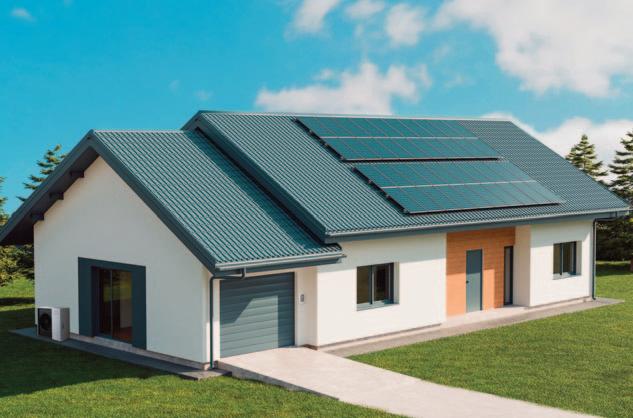
SSE Airtricity is working with governments, local authorities, and domestic customers to support the decarbonisation of homes across the island of Ireland.

As a leading provider of cleaner, greener energy for homes and businesses across Ireland, we are all about making Ireland a more sustainable place.
Stuart Hobbs is the Director of SSE Airtricity Energy Services (AES), a business dedicated to delivering home energy upgrades and utilising energy efficiency technologies to deliver a cleaner greener environment. SSE AES offers home energy upgrades under a number of different government-funded programmes: SEAI One Stop Shop retrofit programmes, Better Energy Homes, local authority energy efficiency retrofit programmes (EERP), and SEAI Warmer Homes. Up to 1.5 million homes in Ireland are in need of energy upgrades by 2050, as energy efficient buildings are essential to meet our climate action targets. These upgrades typically include external wall insulation, energy efficient windows and doors, attic insulation, heating controls, heat pumps, solar PV and battery systems, and electric vehicle (EV) charging points.
Part of the Irish Government’s Climate Action Plan includes a national retrofit programme aiming to see 500,000 homes, one-third of Ireland’s housing stock, retrofitted to a B2 building energy rating by 2030. SSE AES is supporting the retrofit of 40,000 homes in Ireland over the next 10 years, with around 4,000 upgrades already completed. These works will drastically reduce the emissions of thousands of homes, saving millions on energy costs for consumers and making their homes warmer, healthier. Once delivered, this will equal approximately €20 million in reduced energy costs every year.
A Generation Green Home Upgrade from SSE Airtricity is the perfect way to upgrade your home. Hobbs states: “We offer an award-winning retrofit service with a full range of home upgrade options, expert project management and a streamlined grant application process. We have partnered with Ireland’s leading experts in energy efficiency upgrades. From solar PV to windows and doors, internal and external insulation, heat pumps, and EV chargers, we only work with the best. Our customers receive a free home consultation to discuss their home upgrade requirements and receive expert recommendations from our team of specialists. It is one call, it is one job, it is one point of contact.”
SSE Airtricity has been providing home energy upgrades since 2012, working with SEAI, local authorities and other housing bodies on joint initiatives. SSE AES help local authorities deliver their Energy Efficiency Retrofit Programme (EERP) obligations by taking a lot of the hassle and complexity away, enabling
them to deliver larger projects at a better cost and with more flexibility than their own resources might allow. “Over the last decade, we have delivered significant energy upgrades to fuel poor and social housing units, and we have significant ambitions to expand and increase these partnerships. SSE AES’s award-winning service provides a full EERP turnkey solution for local authorities, managing the works from start to finish on a partnership basis with local authorities or housing bodies. We offer pre- and post-BERs, full project design, guidance and preparation and management of all tender documents to be fully compliant with EU procurement requirements, including full end-to-end project management.” SSE AES also compiles all certificates and associated paperwork for the local authorities to make a successful claim to the department. In addition, SSE offers financial support to the project in the form of energy credits generated, as well as offering bridging finance for local authority EERP projects. SSE AES has a body of retrofit contractors and resources ready and able to deliver in all 26 counties in the Republic of Ireland.
Warmer Homes is a nationwide retrofit scheme administered by the SEAI delivering free energy upgrades for households in receipt of certain government benefits. Energy retrofit measures delivered under this scheme include high energy efficiency heating



systems, ventilation, external wall insulation, attic insulation and in some cases windows and doors – making these homes warmer, healthier, and more economical to run. SSE AES is a registered SEAI Warmer Homes contractor to deliver energy upgrades under this national scheme. SSE AES has delivered over 270 home energy upgrades under this scheme since 2020 across a range of shallow and deep retrofit measures and have recently been successfully reappointed to the SEAI 2023 Warmer Homes Contract, to continue delivering energy retrofit upgrades on behalf of SEAI over the next four years.
SSE AES retrofit programmes received awards and recognitions over the past few years for their various retrofit services. Last year alone SSE AES received nominations and secured wins alongside its local authority partner, Dún
Laoghaire-Rathdown, for their upgrade to 58 units in Beaufort OAP Complex in Glasthule. These included winning the Residential Energy Upgrades Awards category at the SEAI Energy Awards 2023, the Local Authority Innovation Award category at the Chambers Ireland Excellence in Local Government Awards, and achieving the gold award in the Energy Initiative/Project of the Year at the All-Ireland Sustainability Awards. Also our One Stop Shop Service won the Best Retrofit Service at the 2024 Bonkers Awards.
For further information on SSE AES programme supports, contact Stuart Hobbs on: T: 087 923 6404 E: stuart.hobbs@sse.com W: www.sseairtricity.com
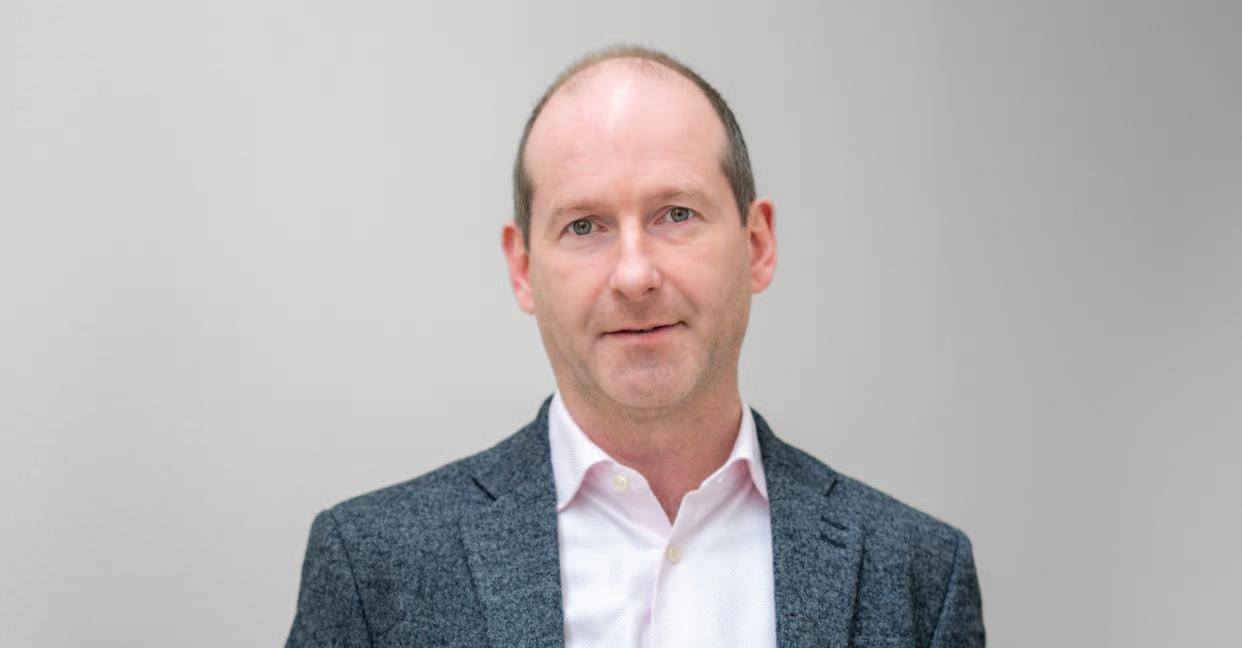
John Curtis, research professor at the Economic and Social Research Institute (ESRI), highlights a crucial but often underestimated factor in homeowners’ decisions about energy retrofits: disruption.
Curtis outlined how the perceived “hassle” of retrofitting – ranging from noise and dust to logistical headaches –can be a major deterrent, even when financial incentives are available.
For policymakers and industry leaders striving to accelerate home energy upgrades, Curtis’ research provides a stark reality check.
“Only about half of homeowners are even realistically considering a retrofit at any given time,” he explains, emphasising that blanket incentive schemes may not be enough to drive widespread adoption. Instead, he
asserts, the key lies in both understanding and addressing the disruptions that cause many homeowners to hesitate.
Home energy retrofits are essential for reducing emissions and improving efficiency, yet uptake remains slower than expected. While much of the focus has been on reducing costs and increasing energy efficiency, Curtis’ research suggests that practical concerns often outweigh financial considerations.
“The perception of disruption varies widely among homeowners,” he notes. His research shows that while some homeowners are willing to endure shortterm inconvenience for long-term benefits, others, particularly older homeowners or those with young families, see retrofits as “too much hassle, regardless of the potential benefits”.
He adds: “Even if homeowners acknowledge the benefits of a retrofit, the effort required to plan, manage, and live through the process often leads them to delay or abandon the idea.”
“Addressing disruption directly –rather than assuming homeowners will tolerate it – may be key to increasing retrofit adoption.”
John Curtis, research professor, Economic and Social Research Institute (ESRI)
Another key challenge Curtis identifies is the complexity of existing heating systems. Since many homes, particularly older properties, have a mix of heating technologies such as radiators, underfloor heating, and solid fuel stoves, this makes it difficult for homeowners to choose the best retrofit solution.
“Most households do not have a single heating system,” he explains. “Instead, they have a combination of different systems, which makes the decision-making process far more complicated.” This complexity, he says, can lead to “decision fatigue”, with homeowners ultimately choosing to do nothing rather than risk making the wrong choice.
There is also the fear that retrofitting could disrupt existing systems without delivering substantial improvements. “For those who already have a working heating setup, the idea of tearing it out and replacing it with something unfamiliar can be daunting,” Curtis states, highlighting the need for clearer guidance and support to help homeowners navigate their options with confidence.
Given these insights, Curtis outlined several ways to address the disruption barrier and encourage more homeowners to proceed with retrofits:
1. Targeting the right homeowners: Since only around 50 per cent of homeowners are genuinely considering retrofits, Curtis advises that policies should be more targeted. “It is not about convincing everyone, it is about making retrofits easier for those who are already inclined to act,” he says. By identifying and engaging these homeowners more effectively, he asserts that resources can be directed where they will have the greatest impact.
2. Reducing perceived and actual disruption: To
make retrofits more attractive, efforts must be made to minimise disruption. This could include offering temporary accommodation for major projects, phased installations, or improved project management services.
“Homeowners need to feel that they can maintain normal life during a retrofit; otherwise, many will opt out,” Curtis says.
3. Providing clearer information and guidance: One of the most significant barriers is uncertainty about what to expect. Curtis stresses the need for more transparent, personalised advice on timelines, costs, and potential disruptions. “Clearer, more practical information could help homeowners make informed decisions rather than feeling overwhelmed,” he says. Case studies and testimonials from homeowners who have successfully undergone retrofits, he states, could also help build trust in the process.
By refining policy approaches, reducing perceived barriers, and improving communication, the ESRI research professor is confident that government and industry stakeholders can help make home energy upgrades a more viable and attractive option.
“If retrofitting programmes fail to account for the real-world challenges facing homeowners, they risk leaving behind a significant portion of households who might otherwise be willing to improve their home’s energy efficiency.
“Disruption is a major, yet often underestimated, factor influencing homeowners’ decisions about energy retrofits,” Curtis says, adding: “While financial incentives and energy savings are important, they are not always enough to overcome concerns about inconvenience and complexity.
“Addressing disruption directly – rather than assuming homeowners will tolerate it – may be key to increasing retrofit adoption,” Curtis concludes.
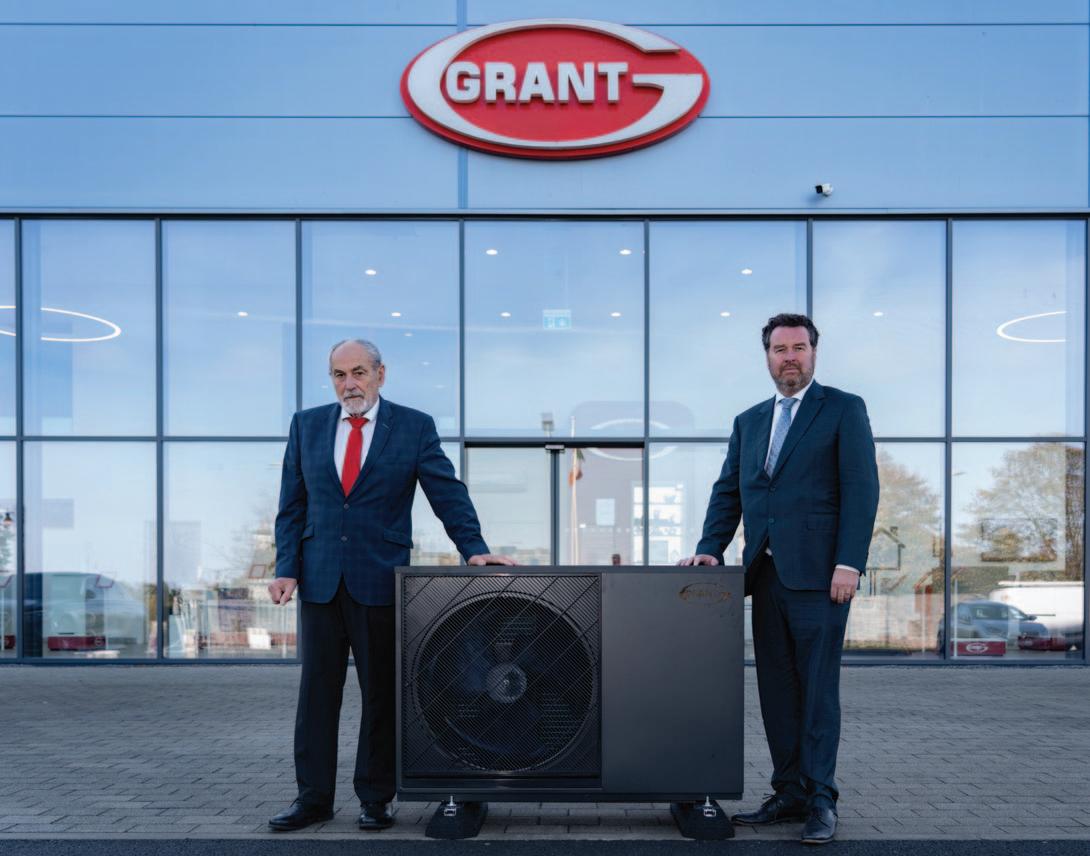
Leading Irish heating technology manufacturer Grant has announced the launch of its new-generation air source heat pump – the Grant Aerona R290, representing an investment of €2.4 million.
Further demonstrating Grant’s commitment to innovation and position as a leader in sustainable home heating, the Aerona R290 was designed in Ireland, specifically for the Irish and UK climate and is already proving itself to be in another league in terms of innovation and efficiency and a significant addition to the Grant product portfolio.
Throughout the research and development phase, Grant invested heavily in the design and testing of the new heat pump range to ensure the technology is best suited for year-round climate conditions in Ireland and the UK.
Innovative and aesthetically pleasing, the Aerona R290 heat pump range has been designed to suit many types of homes and housing projects and features five models in outputs of 4kW16kW. Models within the range can also be monitored and managed remotely giving installers and householders full control of their heat pump system and the ability to provide offsite diagnostic support.
Built upon three core pillars – design, performance, and peace of mind – the A+++ energy rated Aerona R290 provides an even more environmentally friendly, low carbon heating solution for the next generation. It uses the energy efficient and natural refrigerant R290, which has an incredibly low Global Warming Potential (GWP) of 3 compared to other refrigerants commonly used in heat pumps like R32 which has a GWP index of 657, signalling an important advancement in sustainable home heating.
Stephen Grant, Founder of Grant says: “The launch of the Aerona R290 heat pump marks a significant development in sustainable home heating and within our product portfolio. As our newgeneration heat pump, the Aerona R290 comes as Grant celebrates 15 years of being in the heat pump market and is a testament to our commitment to design highly efficient, reliable heating technologies which can make a real sustainable difference. As more homes make the transition to lower carbon heating solutions, we look forward to continuing to support customers through the delivery of technologies, products and services that can help them make a real difference.”
Niall Fay, Director, Grant adds: “We are delighted with the interest that the Aerona R290 is receiving from both trade and local authorities throughout Ireland. As a company we will continue to support the deployment of renewable technologies and the drive towards sustainability and reducing carbon emissions through the development of innovative heating products and training for industry.”
About the Grant Aerona R290 air to water, air source heat pump
• Innovative design
o Environmentally friendly R290 refrigerant
o Ultra-low noise levels recognised by Quiet Mark
o Modern styling and colourway
• Exceptional performance
o Highly Efficient A+++ Energy Rating
o Rated at -5°C air temperature and 55°C water flow temperature
o Five models with outputs from 4kW - 16kW
o Remote monitoring and management
• Peace of mind
o Designed by Grant to suit many types of housing
o Awarded for outstanding innovation
o Design and on-site technical support

Alongside the new Aerona R290 heat pump range, Grant is also launching the Aerona Smart Controller, and QR Smart Pre-Plumbed AWave Integrated Cylinder. These new products will feature within the company’s integrated heating package solutions, providing further choices and flexibility for design and installation whilst providing the same quality and reliability that a Grant heating system is renowned for.
New training courses are available on the Grant Aerona R290 heat pump for those working in the trade and on new build projects. Courses are available to attend on site and online through the Grant eLearning academy.
To find out more information on training please email: training@grant.ie
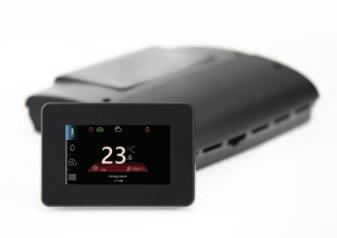
W: www.grant.ie
Twitter: @GrantIRL
Instagram: @Grant_IRL
LinkedIn: Grant Engineering ULC
You Tube: GrantengineeringIE

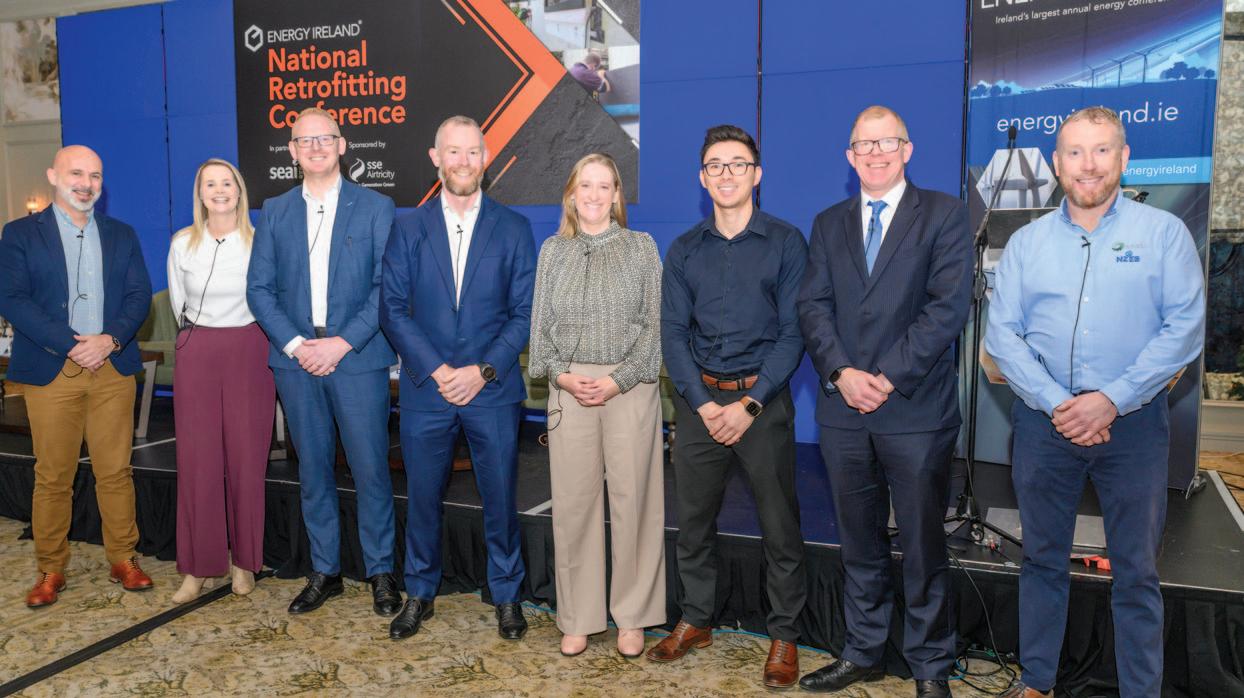
The Energy Ireland National Retrofitting Conference 2024 took place on 28 November at Dunboyne Castle Hotel, County Meath. Around 180 delegates attended the conference which was held in partnership with SEAI and sponsored by SSE Airtricity.
Delegates in attendance heard from speakers, both visiting and local, from organisations including the European Heat Pump Association; Department of the Environment, Climate and Communications; Irish Green Building Council; Dún Laoghaire-Rathdown County Council; TU Dublin; and Economic and Social Research Institute.








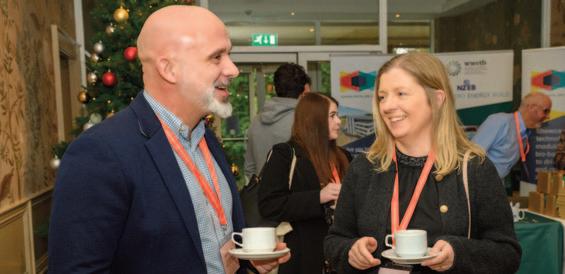




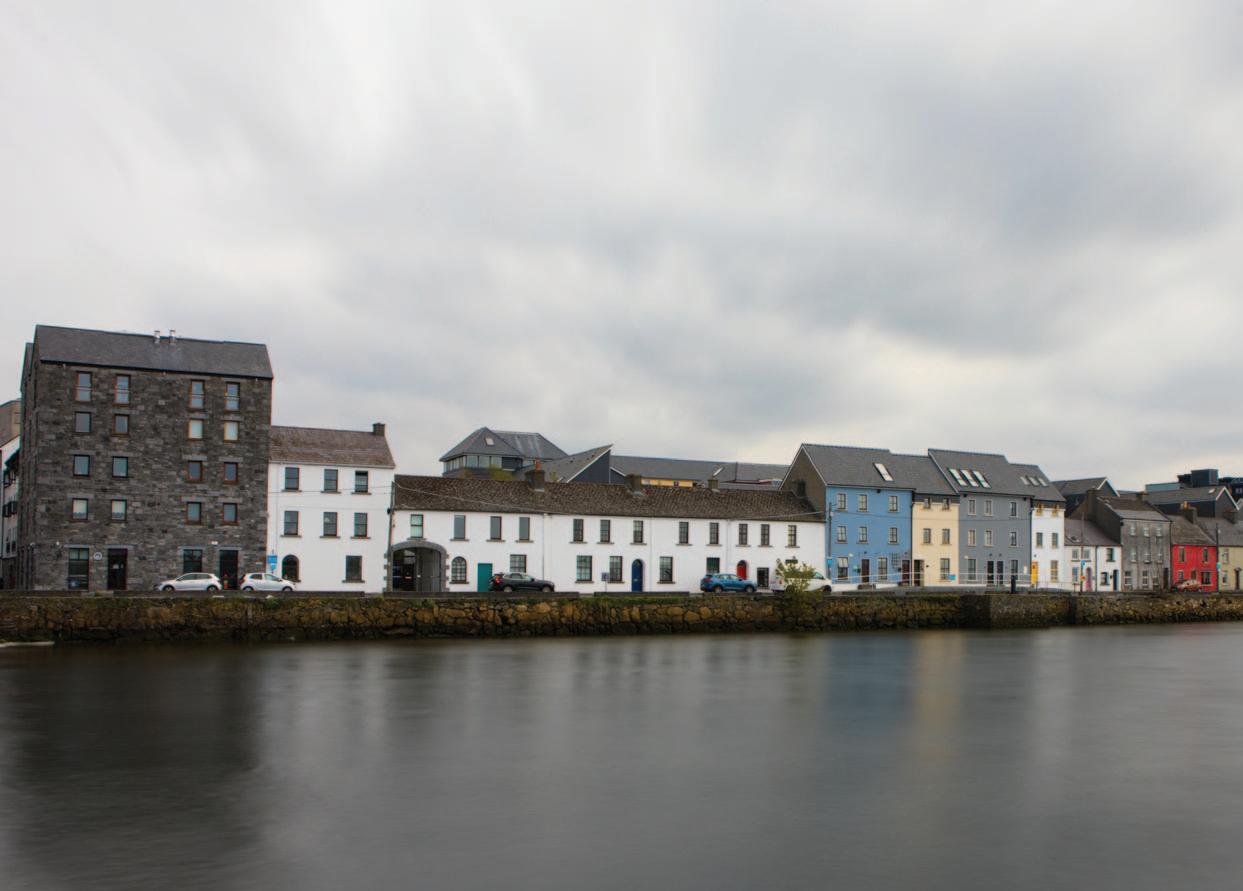
Galway City is participating in the EU NetZeroCities Pilot Cities Programme and is testing innovative ways to reduce the city’s carbon emissions. Galway City’s project focuses on energy efficiency in buildings and aims to address the barriers associated with retrofitting homes.
The project involves:
• The establishment of a community one-stop-shop (Warm Home Hub) to provide information and guide households through their retrofitting journey;
• Research on retrofitting skills and training courses for contractors and the development of measures to address any gaps in provision and uptake;
• A multi-agency steering group tasked with addressing the challenges faced by households in relation to retrofitting at local, regional and national levels; and
• The sharing of knowledge and experience with other European cities, through twinning and learning arrangements.
The NetZeroCities pilot project is based in Galway City’s Decarbonisation Zone, covering a population of c. 7,000 in the Westside and Shantalla areas of Galway City. Led by Galway City Council, the aim of the project is to increase retrofitting rates in this area by working directly with the community and trialling different approaches of engagement and delivery. Galway is one of 104 cities across Europe selected for the NetZeroCities Pilot Cities Programme. The Programme aims to test innovative solutions to rapid decarbonisation over a two-year period. For more information, check out www.netzerocities.eu/pilot-citiesprogramme.

Warm Home Hub, Westside Resource Centre, Seamus Quirke Road, Galway (091) 398125 / (085) 1986975
info@warmhomehub.ie www.warmhomehub.ie
The Warm Home Hub serves as a onestop-shop for residents in Galway’s Decarbonisation Zone seeking to retrofit their homes. Located in the Westside Resource Centre, it offers support to householders, consultation with contractors, and educational sessions on the benefits and process of home energy upgrades. The hub makes retrofitting more accessible to residents by guiding them through every step of the process.
Key features of the Warm Home Hub include:
• Community engagement and education;
• Accessible and available expert support;
• A step-by-step retrofit pathway;
• Free home energy assessments;
• Data analysis for informed decision-making and targeted campaigns.
The Warm Home Hub team offer oneon-one consultations to households and can provide bespoke guidance, based on individual properties. The team also host workshops, drop-in clinics, family events and more to increase awareness on energy efficiency and retrofit options. Working closely with existing schemes, such as SEAI Sustainable Energy Communities and the Healthy Age Friendly Homes Programme, the Warm Home Hub serves as an honest broker for all actors in the retrofit chain.
The Warm Home Hub is an independent and community-based service offering free support and guidance on energy efficiency and home energy upgrades.

Other elements of the Galway NetZeroCities Pilot Cities Programme are:
The Retrofit Accelerator Programme is designed to address key challenges in upskilling and workforce development for retrofitting. Led by the University of Galway, in collaboration with Atlantic Technological University, this work seeks to identify gaps in education and training offerings, assess the reasons behind low participation in existing programmes, and finds ways to increase engagement.
A multi-agency steering group has been established to bring together key stakeholders – government, industry, academia, and civil society – and drive systemic change in the approach to energy efficiency.
The Galway City NetZeroCities pilot cities programme runs from June 2023 to May 2025. The project consortium are Galway City Council, Atlantic Technological University, Galway Energy Co-operative, Northern and Western Regional Assembly, and the University of Galway.
This project has received funding from the H2020 Research and Innovation Programme under the grant agreement n°101036519.
For more information, visit: E: climate@galwaycity.ie W: www.netzerocities.eu



Merepark housing development is the latest addition to the Altidore Gardens community, located in Newtownmountkennedy, County Wicklow. Central to this development is a focus on sustainability, innovation and connectedness to the scenic surrounding beauty of the Wicklow mountains.
With a total of 154 houses in this development, it was important to get the heating and domestic hot water systems just right. D/RES, the developer and one of Ireland's leading sustainable private housebuilders, wanted to create energy efficient homes that would provide the homeowner with both comfort and reliability. Mitsubishi Electric collaborated with McGuinness Mechanical, a leading mechanical engineering contractor, from the earliest stages of this project’s inception to achieve this. The McGuinness design team worked closely with Mitsubishi Electric throughout the project’s lifecycle, collaborating on site visits, designs, heat loss calculations, selections and sizing the units.
With the goal of sustainable living with modern comfort, Mitsubishi Electric Ecodan heat pumps were the perfect fit for the housing development. Ecodan Heat Pumps are the renewable, low
carbon alternative to traditional high carbon heating systems, and provide reliable, renewable heating technology that delivers highly efficient sustainable space heating and hot water all year round.
“Mitsubishi Electric has reliability, green credits, sustainability and that sort of background to it and we felt that a partner like them with their knowledge, their background, their historical track record that’s really what we were looking to partner with”, says Brett Chrystal, Head of Sustainable Design at D/RES Properties.
All homes were fitted with a 6kW Split Mitsubishi Electric Ecodan Heat Pump. The Ecodan outdoor units provide an innovative, stylish and compact single fan unit. The outdoor unit upgrades freely available heat energy from the air and transfers it to the home to provide space heating for radiators and/or under floor heating. It utilises advanced technologies
to deliver improved efficiencies. However, an Ecodan is not only highly efficient; it is also one of the quietest units available on the market.
Each property was fitted with a 170L indoor unit. These indoor units handle the space heating and DHW demand. An Ecodan provides the home with a continuous supply of hot water via a dedicated hot water cylinder – just like a standard boiler.
With an Ecodan Heat Pump, there is a range of controls to choose from including an advanced wireless controller. A simple room controller allows the homeowner to control their own system and monitor its performance remotely. With the MELCloud Home App any smart device can be connected and control the heating and hot water locally, contributing to the overall efficiency of the property and giving tailored comfort to each household.
However, for the homeowner the Mitsubishi Electric journey does not stop once the site is finished. All the household units are registered to the INSTALL ME App, meaning the homeowner will get a notification when their unit is due to be serviced. To ensure maximum performance from an Ecodan Heat Pump throughout its working life, the system needs to be regularly serviced and maintained. Service can be provided by the installer or by Mitsubishi Electric.
For more information: W: les.mitsubihsielectric.ie
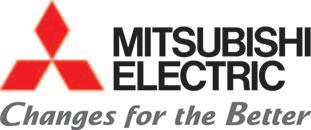



Behavioural economist Evelina Gunnarsson discusses the application of behavioural insights to encourage energy efficient renovations.
“By combining a system approach with behavioural insight, we can tackle structural barriers, streamline processes and foster sustainable habits,” says Gunnarsson, who believes that understanding human behaviour is essential to influencing energy renovation decision-making.
Highlighting that driving sustainable change is more often than not underpinned by making the best choices the easiest ones, Gunnarson is quick to point out that even the best technical solutions can fail, if they do not align with how people actually think and behave.
Exploring this further, the behavioural economist is quick to point out that humans, despite the beliefs they hold, are not always rational decisionmakers, with choices often influenced by external factors.

Showcasing the point, she asks: “How many people leave a light on in their home or their phone charger connected, even when they know it wastes energy? Similarly, how many people go shopping with a list of healthy items, only to find themselves adding some less healthy items when shopping?”
This, Gunnarsson explains, is an example of how human choices do not always align with intentions and underpins the challenge of accelerating energy efficiency: turning good intentions into consistent actions.
Classified as the “intention-action” gap, Gunnarsson says this gap is evident in homeowners who want more energy efficient homes, but fall short taking the actions required to make it happen, even when the long-term benefit is evident. The behavioural economist points to three defining factors which
influence human decision-making:
1. Status quo bias: Sticking with the current situation appears easier than change, even if that change has long-term benefits;
2. Social norms: Seeing neighbours or peers adopt energy efficiency solutions can inspire action. Conversely, a lack of physical adoption can reinforce inaction;
3. Information and choice overload: Too many options and too much information can lead to indecision or wrong decisions.
“Understanding human behaviour is essential,” she says. “A sustainable change is often about making the better choice, the easiest one.”
Gunnarsson points to research done in Germany which underpins this point. A study compared green energy uptake in
• Increase awareness and engagement by using crucial messengers as advisors
• Tailor key messages to different target groups
• Target owners at key ‘trigger points’.

households who had to opt in against households automatically opted in, but with an option to opt out. The results showed that the green energy adoption rate soared when green energy was the default.
“This is a powerful reminder that small adjustments in how choices are presented or framed can create great impacts,” she states.
Gunnarsson’s organisation Ramboll recently carried out a study for the European Environment Agency with the aim of understanding behavioural factors influencing energy efficiency renovation uptake in residential buildings across the EU.
The study identified important stakeholders influencing energy renovations in residential buildings such as homeowners, intermediaries, suppliers and others, but also prioritised some groups based on their influence over decisions and their roles in the renovation process. The study particularly focused on ownership, recognising that this is where ultimate decisions and costs lie, but categorised the various forms of homeownership to include landlords. It also focused on installers and contractors, who often directly influence energy consumption through the solutions they propose.
Outlining the most prominent practical factors affecting stakeholder’ decisionmaking identified in the study, Gunnarsson points to some key drivers:
Improved living conditions: Owners are privately motivated by the desire to enhance thermal comfort and indoor living conditions.
• Make the decisionmaking process easier for owners
• Make the available financial support and programmes more appealing to owners
• Clarify the financial benefits of implementation.
Social and environment engagement: Appearance improvement is not only a strong driver for those who love n their homes, but also for landlords who recognise that improvements increase tenant satisfaction and raises the property value.
Energy efficiency: Energy efficiency is often a primary goal or outcome of renovation.
Influence from trusted sources: Owners are more likely to act when the advice comes from a trusted source.
On some of the barriers identified, the behavioural economist says: “Unsurprisingly, one of the largest obstacles is the ‘hassle’ factor, the perceived effort and disruption caused by renovation, and this is not limited to the physical work, it includes price comparison, grant applications or even in some cases the thought of having to clear out the attic before work can begin. Bureaucratic barriers can often be a greater obstacle than the cost itself.
“However, perceived financial risk by owners is a barrier, particularly when there is a high upfront cost and this risk aversion plays a strong role.”
In relation to installers and contractors, Gunnarsson says that although not behavioural, a lack of skilled workers with adequate training means that contractors may feel less confident in recommending or implementing innovative or new energy efficiency solutions.
The report breaks the complex decision-making process for owners
• Combine the implantation of energy efficiency measures with training from a trusted advisor.
into three key categories:
Understanding that there is a need to renovate; searching for an appropriate energy efficiency renovation measure; and carrying out the renovation.
“Based on these different phases, we recommended solutions based on the different stages of the decision-making process. Because, by tailoring the different solutions to different target groups, we can better support owners and overcome the different barriers, or use the drivers that we identify,” she explains, with findings set out in the table below.
Concluding, Gunnarsson says:
“Understanding how human behaviour shapes decision-making is crucial for designing effective interventions, and behavioural science can help bridge the gap between attention and action, while enabling tailormade solutions for each stage for the renovation journey. Importantly, depending on the target group, one solution does not fit all.
“We must recognise the power trusted messengers and community engagement has on the decisionmaking process, and underpin this by simplifying the financial and administrative processes, to make those best actions the easiest ones to take.
“Finally, we must combine these behavioural insights with a system approach. Energy renovation does not exist in isolation, it is part of a broader system of policies, markets, communities and individuals. By combining a system approach with behavioural insight, we can tackle structure barriers, streamline processes and foster sustainable habits.”

Five years since the introduction of retrofit targets of 500,000 homes to ‘B2’ BER standard or above, the Government has retrofitted approximately 55,893 homes to said standard. Meeting the 2030 target will now require an average annual retrofit of approximately 63,444 homes. eolas Magazine examines the depth of the commitment to the retrofitting agenda in the Programme for Government (PfG).
In 2020, the then-government set forth an ambitious agenda to enhance the energy efficiency of the State’s building stock, aiming to retrofit over 500,000 homes to a Building Energy Rating (BER) of B2 or higher by 2030. This initiative was a cornerstone of the State’s strategy to reduce carbon emissions, acknowledging that approximately 40 per cent of the country’s energy-related carbon emissions originated from buildings.
The National Retrofit Plan also included retrofitting approximately 36,500 local authority-owned homes.
Five years on, the 2025 Programme for Government reaffirms and expands upon these commitments, introducing a series of measures designed to accelerate progress in retrofitting and sustainable energy adoption. This analysis evaluates the 2025 commitments against the 2020 targets,

highlighting advancements and areas requiring attention, and offers insights for policymakers in the Irish retrofitting sector.
The 2025 Programme for Government pledges to “ramp up our targets to deliver more B2-equivalent home retrofits each year from 2026 to 2030, with a focus on lower-income households”. This commitment not only reinforces the original goal of retrofitting
500,000 homes by 2030 but also emphasises social equity by prioritising lower-income households. This approach aligns with the National Retrofit Plan’s objective to address barriers to retrofitting, particularly for vulnerable populations.
Recognising the financial challenges homeowners face in undertaking retrofitting projects, the Government plans to “revise and improve the provision of grants and financing models,” ensuring accessibility for older community members.
The introduction of the €500 million Home Energy Upgrade Loan Scheme, offering low-interest loans ranging from €5,000 to €75,000, aims to make retrofitting financially attainable for a broader segment of the population. This initiative complements existing schemes and aims to stimulate demand by reducing upfront costs.
The PfG introduces innovative approaches such as supporting group retrofitting projects, enabling neighbours to collaboratively upgrade their homes. This strategy is designed to make the process more economical and less daunting for individual homeowners.
Additionally, the Government aims to increase the number of sustainable energy communities, by “fostering local engagement and collective action in energy efficiency efforts”.
Building upon pilot schemes, the Government also proposes developing mechanisms that allow private homes within social housing estates to opt into retrofitting projects at adjusted costs. This approach aims to ensure that all residents, regardless of ownership status, have the opportunity to benefit from energy efficiency improvements, thereby promoting community-wide sustainability.
Targeting older homes that still rely on oil heating, the Government encourages a switch to renewable heating systems, aiming to lower carbon footprints and reduce costs. In scenarios where deep retrofits are not immediately feasible, the consideration of biofuels, such as hydrotreated vegetable oil (HVO), offers a transitional solution. The emphasis on improving traceability in HVO procurement underscores the commitment to environmental integrity.
Category 2030 targets (2020 PfG)
Overall home retrofits
500,000 homes to BER B2 by 2030
Social housing retrofits
36,500 local authority-owned homes retrofitted
Community initiatives
Financial support
Renewable heating transition
Increase the number of sustainable energy communities (SECs)
Expand grant and financing models for retrofitting
Phase out oil and gas heating in favour of renewables
District heating Expand district heating networks
Skills and workforce development
Carbon tax usage
Train workers to meet retrofitting demand
Use revenue to fund retrofitting and social measures
Skills capacity constraints has been an obstacle to progress in retrofitting. The PfG outlines the provision of upskilling and training opportunities across the green economy, including the establishment of industry centres of retrofitting excellence nationwide. This focus on education and training will be critical to building the capacity required to meet the increased demand for retrofitting services.
A key challenge with meeting retrofitting targets has been that it is hard to sell to consumers due to the disruption it causes to one’s home, and the amount of debt is requires the homeowner to take on.
Progress to date Objectives in 2025 PfG
~55,893 homes retrofitted to BER B2 or higher (as of October 2024)
Ongoing: Latest figures not publicly available
SECs growing: Progress in community-led projects
€500 million Home Energy Upgrade Loan Scheme introduced in 2023
Slow progress: Oil heating still prevalent
Ramp up annual B2 retrofits from 2026 to 2030, prioritising lower-income households

Limited implementation
National Retrofit Plan launched: Training programmes initiated
Ongoing investment from carbon tax revenue
Expand schemes to allow private homes in social housing estates to opt in at adjusted costs
Further increase SECs and support group retrofitting projects
Revise and improve grants: Ensure accessibility for older people
Support oildependent homes in switching to renewable heating explore sustainable biofuels
Enact legislation in 2025 to accelerate rollout of district heating
Establish industry centres of retrofitting excellence nationwide
Continue funding retrofitting through carbon tax revenues
While polling shows that there is a desire among the population to meet environmental challenges, the proposals under the PfG fall short of outlining how government and the retrofitting industry can sell the intrinsic value of retrofitting homes to the general public.
The industry is significantly more developed than when it was introduced at scale in 2020, meaning that there is scope for progress. However, unless further reform is to come, it is difficult to imagine how government can bridge the gap from retrofitting an average of just over 11,000 homes per annum, to 63,444 per annum.